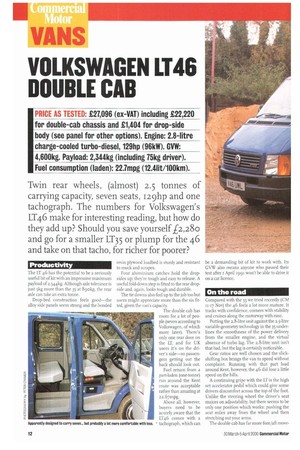VOLKSWAGEN LT46 DOUBLE CAB
Page 14

Page 15

If you've noticed an error in this article please click here to report it so we can fix it.
IFI4PRICE AS TESTED: £27,096 (ex-VAT) including £22,220 double-cab chassis and £1,404 for drop-side body (see panel for other options). Engine: 2.8-litre charge-cooled turbo-diesel, 129hp (96kW). CR: ,600kg. Payload: 23344kg (including 75kg driver). Fuel consumption (laden): 22.7mpg (12.411t/100km).
Twin rear wheels, (almost) 2.5 tonnes of carrying capacity, seven seats, 129hp and one tachograph. The numbers for Volkswagen's LT46 make for interesting reading, but how do they add up? Should you save yourself £2,28o and go for a smaller LT35 or plump for the 46 and take on that tacho, for richer for poorer?
Productivity
The LT 46 has the potential to be a seriously useful bit of kit with an impressive maximum payload of 2.344kg. Although axle tolerance is just 5kg more than the 35 at 890kg, the rear axle can take an extra tonne.
Drop-bed construction feels good—the alloy side panels seem strong and the bonded resin plywood loadbed is sturdy and resistant to muck and scrapes.
Four aluminium catches hold the dropsides up; they're tough and easy to release. A useful fold-down step is fitted to the rear dropside and, again, looks tough and durable.
The tie downs also feel up to the job too but users might appreciate more than the six fitted, given the van's capacity.
The double cab has room for a lot of people (seven according to Volkswagen, of which more later). There's only one rear door on the LT, and for UK users it's on the driver's side—so passengers getting out the back should look out.
Fuel return from a part-laden (one-tonne) run around the Kent route was acceptable rather than amazing at 22.67mpg.
Above all, however, buyers need to be acutely aware that the LT46 comes with a Apparently designed to carry seven... but probably a lot more comfortable with less. • tachograph, which can
be a demanding bit of kit to work with. Its GVW also means anyone who passed their test after r April 1991 won't be able to drive it on a car licence.
On the road
Compared with the 35 we tried recently (CM 11-17 Nov) the 46 feels a lot more mature. It tracks with confidence, corners with stability and cruises along the motorway with ease.
Putting the 2.8-litre unit against the 2.5-litre variable-geometry technology in the 35 underlines the smoothness of the power delivery from the smaller engine, and the virtual absence of turbo lag. The 2.8-litre unit isn't that bad, but the lag is certainly noticeable.
Gear ratios are well chosen and the slickshifting box brings the van to speed without complaint. Running with that part load around Kent, however, the 46 did lose a little speed on the hills.
A continuing gripe with the LT is the high set accelerator pedal which could give some drivers discomfort across the top of the foot. Unlike the steering wheel the driver's seat majors on adjustability, but there seems to be only one position which works: pushing the seat miles away from the wheel and then stretching out your arms.
The double cab has far more fore/aft move ment here than a single cab, but drivers pushing the seat back that far would need the long arms of an orang-utan to reach the steering wheel.
Turning circle is good, which is a consider, a tion for buyers who need to carry a lot of load but want to steer clear of bigger, more cumbersome units around the 7.5-tonne mark. Manoeuvring is easy at low speeds and the .;ti-ering is well able to turn from lock to lock t standstill.
Cab comfort
Build quality can't be questioned in a Volkswagen, but lack of storage space continues to be a problem for the LT Although the fuse box and tools are hidden away very nicely, there are precious few other storage opportunities in the cab.
Heater temperature is as easy to control as a go-kart on an ice rink and the hi-spec, multi-function Sony radio has infuriating
midget-sized buttons. These are far too distracting and draw the eye away from the road too easily and for too long. Big buttons are better, while steer wheel stalk-mounted controls are best (tab1 bow, Renault: your Master has certainly be a good influence).
As for the crew cab, seven passeng( seems a shade ambitious—those in the ba would certainly want the journey to be shor they were sitting four abreast, and anyone ting in the outer rear seats will find them la( ing in support which is a strange thing fo Volkswagen.
IMI=MEMI Volkswagen's LT46 occupies an odd wo: between jump-in-and-go 3.5-tonners and b ger, no-nonsense 7.5-tonne set-ups. The f that CM has tested so few vehicles in t.1 bracket is testament to this, but doesn't me that some buyers wouldn't benefit from wi the 46 has to offer. If the LT35 really does pack enough payload and you need to new ate tight sites, then get hitched to a 46.
• by Toby Clark
















































































































